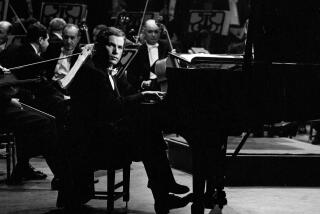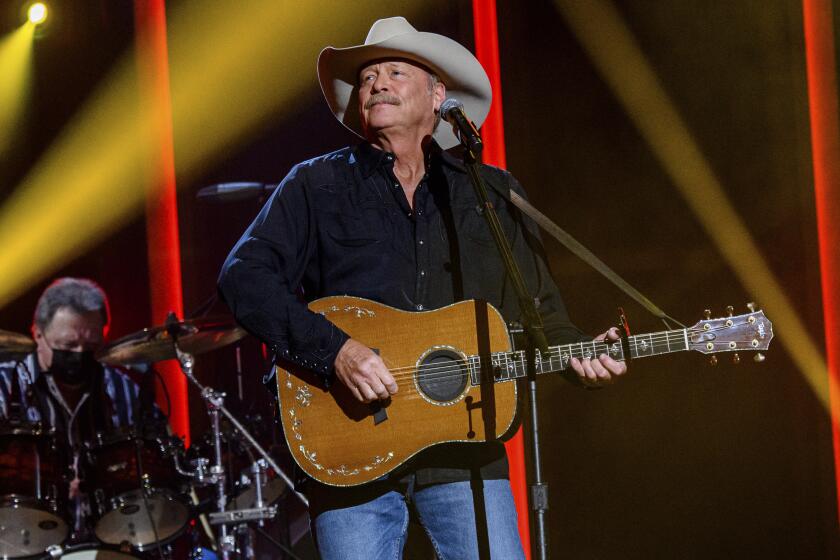Hank Ballard, 66; Found the B-Side of Fame in Writing, Recording ‘60s Hit Tune ‘The Twist’
- Share via
Hank Ballard, the R&B; star who wrote and recorded “The Twist” with little success and watched a year later as Chubby Checker used the song to teach the world a new dance, died Sunday at his home in Los Angeles. Ballard, who had been suffering from throat cancer, was 66.
Inducted into the Rock and Roll Hall of Fame in 1990, Ballard was the lead singer of the Midnighters vocal group and was hailed in the R&B; world for his influential mixture of raunchy lyrics and gospel rhythms in hits such as “Work With Me, Annie.” Ballard’s greatest song success, though, was co-opted by Checker, who took Ballard’s 1958 B-side “The Twist” and turned it into a national craze.
“People think Chubby wrote it, but they’re wrong,” Ballard told The Times in 1988. “They call Chubby the father of ‘The Twist,’ but he’s just the stepfather. I’m the father. It’s my baby.”
For Ballard, the success of Checker’s version of “The Twist” -- it hit No. 1 in 1960 and again in 1961 and spawned a sequel hit, “Let’s Twist Again,” in 1961 -- was a bittersweet theme in his own career. The royalties from the song buoyed him through the years and opened some doors for his own recordings, but he remained largely anonymous in Checker’s large shadow.
“We made history with the song, and Hank Ballard made all of that come about,” Checker said Monday. “He will be missed. But he is still alive because of that song and because of Chubby Checker. Even after I’m gone, the song will keep me alive too. The biggest thing to this day in rock ‘n’ roll and in pop music with a beat is two people, dancing apart and facing each other. And that never happened before we did ‘The Twist.’ ”
Ballard had recorded the song in a heavy, somewhat leering style, and it stirred only brief interest at R&B; radio stations. It was Dick Clark, the radio and television personality whose “American Bandstand” TV show was instrumental in the growth of rock ‘n’ roll in mainstream America, who heard a bigger hit and auditioned performers who might craft a slicker, more pop-leaning version.
“He was chosen because he came closest to my sound,” Ballard told The Times about the selection of Checker. “He beat me with my own sound. I never spent much time worrying about it, despite what people say. If I had, it would have eaten me up by anger by now.”
Clark said Monday that he viewed “The Twist” as the most important song in rock ‘n’ roll. “It was the first time the adult population could embrace rock ‘n’ roll,” Clark said. “Before that, adults were ashamed to say they liked it. They were folk fans, jazz fans -- there was a sense that pop music was only for kids. But this song became a darling of high society and every demographic.”
Henry Ballard was born Nov. 18, 1936, in Detroit, but at the age of 7, when his father died, Ballard was sent to Bessemer, Ala., to be raised by relatives. The new home was a strict Baptist one, and Ballard chafed under the restrictions even as he became entranced by the gospel music he sang in choir. He often slipped out his window at night to go to Birmingham to compete in amateur blues shows.
At the age of 15, he ran away and found himself back in Michigan, working at Ford Motor Co. On the assembly line, Ballard would sing everything from church songs to Gene Autry hits.
The teenager’s voice caught the ear of Sonny Woods, a factory worker who was a member of the doo-wop group the Royals, whose changing membership would include Jackie Wilson and Levi Stubbs of the Four Tops. Ballard joined the group, and when lead singer Lawson Smith left for the military in 1951, he took over that role.
Bandleader Johnny Otis soon put the Royals in the studio and Ballard was on his way to a wider audience.
By late 1952, he had pulled the group away from romantic harmony songs and toward an earthier version of R&B.; In 1953, they had a top-10 hit on the R&B; charts with the lusty rendition of “Get It.”
By 1954, the group changed its name to the Midnighters, and had a sensation on its hands with the “Annie” songs -- a series of bawdy hits that were banned or ignored by pop radio but sold more than 1 million records worldwide and became a taboo treasure among giggling youngsters.
The first was “Work With Me, Annie” in April 1954, and the consequences of the subject’s labors became clearer five months later in the sequel hit “Annie Had a Baby.” A third installment by year’s end was “Annie’s Aunt Fannie.”
Singer Etta James responded in her own song, “Roll With Me, Henry,” but that was also deemed too coarse for pop radio.
As was common in that era, some of Ballard’s hits were rerecorded for white, pop audiences, with toned-down imagery and a less bluesy style. “Work With Me, Annie,” for example, was turned into the 1955 No. 1 pop song “Dance With Me Henry (Wallflower)” by Georgia Gibbs.
In 1954, “Work With Me, Annie,” “Sh-Boom” by the Chords and “Gee” by the Crows were R&B; songs that cut through to white American youth and helped pave the path for the looming rock ‘n’ roll movement led by Elvis Presley, Little Richard and Chuck Berry. The coded sexuality of “Annie” was also a precursor of the rock ‘n’ roll to come.
After the “Annie” songs, the recording run for the Midnighters cooled off, and their next big hit was the more sentimental “Teardrops on Your Letter” in 1959. That single had a novelty song, “The Twist,” as its flip side, one that Ballard would later say was inspired by the stage antics of his bandmates. The tune, he said, was pinched somewhat from “What’cha Gonna Do” by the Drifters.
“The Twist” did not take off for the Midnighters, but Checker’s version became a phenomenon. Checker said he had seen “kids in the neighborhood make up a dance” to the original version of the song, and that inspired his stage performance of “looking like I was putting out a cigarette with two feet.”
Ballard’s version of “The Twist” was re-released in the wake of the craze and it peaked at No. 28 on the pop charts. His other top hits included “Finger Poppin’ Time,” which hit No. 7 on the pop charts in 1960, and, later that year, “Let’s Go, Let’s Go, Let’s Go,” which peaked at No. 6.
Ballard continued with his music career and had top-10 hits on the R&B; charts in 1961, 1968 and 1971.
The Midnighters broke up in 1963, but Ballard retained the name for touring. He joined James Brown’s revue for several years, and the famous soul singer has paid tribute to Ballard on his albums.
Ballard continued to release singles. His “Let’s Go Streaking” in 1974 probably reminded older fans of the raunchy spirit of the less overt “Annie” songs years earlier. Ballard, a compact, effusive man who was ever the showman, hyped the release by recording the song in the nude.
Ballard slowed down his career considerably after the 1990 death of his wife and manager Theresa McNeil, who was killed in a hit-and-run crash.
Three months later, a tearful Ballard grieved for his wife as he was inducted into the Rock and Roll Hall of Fame. At the time “The Twist” was fresh on the minds of the record industry -- the song was back in the top 40 in 1988 with a reworking by the rap group the Fat Boys.
Checker offered a personal summation of Ballard’s most famous tune: “People don’t think of him as the person that wrote the most important song, but that doesn’t make it an untruthful thing. And if it weren’t for him and it weren’t for ‘The Twist,’ where would I be?”
More to Read
The biggest entertainment stories
Get our big stories about Hollywood, film, television, music, arts, culture and more right in your inbox as soon as they publish.
You may occasionally receive promotional content from the Los Angeles Times.










